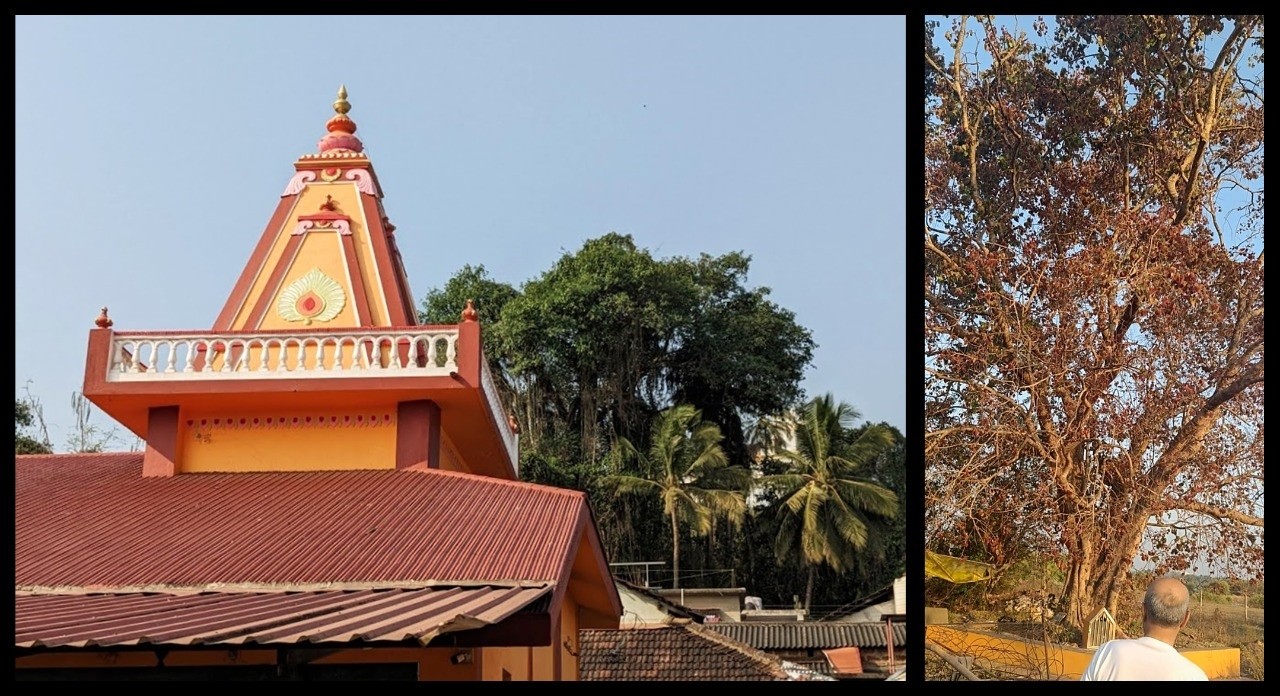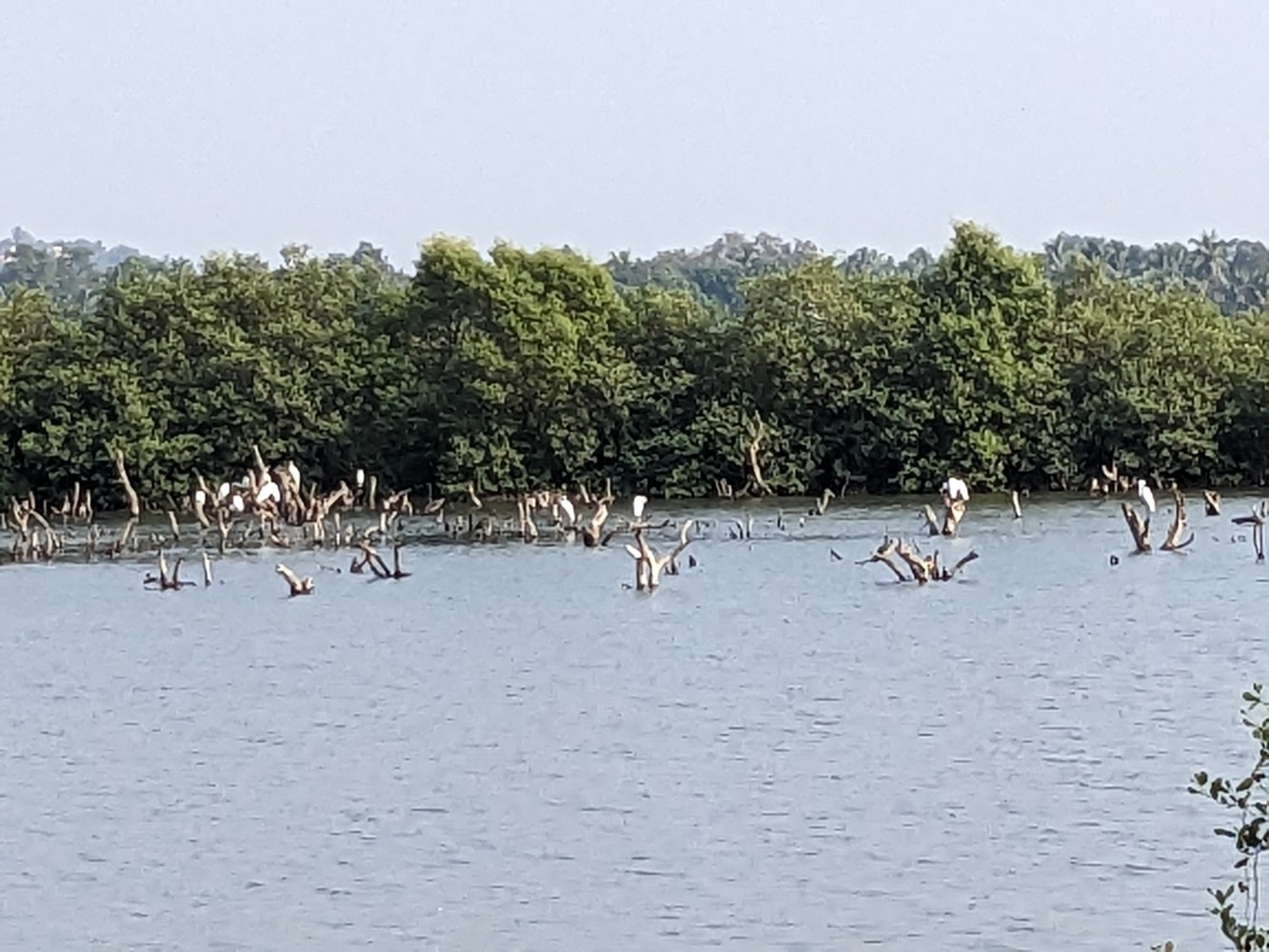Goa is a popular tourist destination known for its beautiful beaches, delicious seafood, centuries-old churches, temples, ruins of forts, casinos, and of course the lively nightlife. However, there’s much more to this smallest of the Indian states than meets the eye, that does not find a mention in the bucket list of tourists. I recently visited Wadwad, a small village with a population of about 400 residents, which is located off National Highway 66 (NH 66). The visit was a revelation of the natural beauty and serenity Goa offers.
In Goa, NH 66 runs North-South, hugging the coast through the entire length of Goa. Agacaim can be reached from Panjim by taking the left exit either before or after the second flyover on NH 66 after leaving Panjim. A panoramic vista comes into view on the left from the flyover. Hundreds of meters below is a large lagoon comprising rectangular water bodies of different sizes separated from each other by narrow strips of land. Beyond the lagoon are villages, partially hidden by the lush greenery that extends well beyond the villages to the gently sloping hillsides. Perplexed the first time I saw them, I realized that the white dots were reflections of sun rays from the white plumage of egrets resting on the treetops and flying across the lagoon.
I roped in Kishan to drive me to the lagoon and the surrounding villages one Winter afternoon. Finding the way to the lagoon turned out to be surprisingly difficult. After a couple of abortive attempts, we took a sharp left turn onto a village road from the road to Agacaim, about 500 meters from the first exit on NH 66. The first village on the road was a large village, Palem. As we drove slowly through Palem, we could initially see water bodies through the gaps between the houses on our right. The road was gently veering to the left and was also moving uphill. We soon realized that we could no longer see the water bodies beyond the houses. As we climbed up, we saw a signboard informing us that we were headed to Curca. As we drove through the prosperous-looking village of Curca, with lovely old mansions, we knew that we were getting further away from the lagoon that necessarily must be at the foothills!
Did we miss a turn on the way up from Palem that would have taken us downhill? Wasn’t there a sharp right turn immediately after Palem to a much narrower road? As we were driving Thar, a large SUV, we were reluctant to turn right on our way out of Palem as the road appeared too narrow for Thar. We retraced our path and reached the junction where the much narrower road forked from the village road between Palem and Curca. I asked Kishan whether he was comfortable taking the now left turn into the narrow road. A person of sunny disposition with supreme confidence in his driving skills, he said, “Yes, sir. If I am unable to make a U-turn to return, I would bring the vehicle back to the junction driving in the reverse gear!” As the narrow winding road was taking us downhill, the direction of travel appeared to be right.
We drove through the small hamlet, almost trespassing over the front courtyards of houses. We noticed the surprised looks on the faces of the villagers who wondered what the outsiders were doing in their village on a lazy Winter afternoon. We could not see any water bodies through the thick foliage. We had no choice but to keep moving forward in the hope that we would eventually be able to either reach the lagoon or a wider road. The road eventually turned out to be a cul-de-sac and ended in a large open ground beyond the village houses. Several cars were parked on the right of the road occupying a part of the open ground that clearly acted as a parking lot. We alighted from the vehicle. We were all by ourselves with not a soul in sight. On the left of the road, set against the backdrop of a hillock, was the Bhumika Devi temple, which was majestic relative to the much smaller village houses. Right in front of the temple, on the right side of the road was a mighty twenty-meter-tall Peepal (that is also known as the Sacred Fig) tree. The tree is considered sacred by Hindus, Jains, and Buddhists and is often planted near temples and holy shrines. Covered entirely with fresh red leaves the tree was going through its annual cycle of renewal of life. Swaying with an imperceptible rustling sound in the gentle breeze the leaves glistened in the reflected sunlight. As I stood there gazing at the temple and the tree, time stopped, and life came to a standstill. I experienced a rare moment of utter tranquillity.

We looked around and noticed a path through the grass past the Peepal tree that appeared to lead to the lagoon on our right and ahead of us. The water was still in the smaller ponds. There was a hint of ripples on the surface of the larger ponds due to the gentle afternoon breeze from the sea on the West. The lagoon abounded with birds. We spotted many egrets, black drongos, and herons on the shrubs and trees surrounding the water bodies and sitting on the stumps of dead trees sticking out from the water in the ponds. The golden reflection of the setting sun in the water lent an ethereal beauty to the lagoon.

As we moved further into the lagoon by walking on the land that separated the water bodies, entirely unexpectedly we came across a man who was lying face down on a cot in the middle of a makeshift shed with a cloth tied to four poles to provide shade. Curious, we asked the man, “What are you doing here?” He looked at us with no expression. We further asked, “Are you here to catch fish?” Looking a little surprised, he said, “No.” Without saying it the man was asking us, “Can’t I just enjoy an afternoon siesta in the lap of nature?” We retreated realizing that we were unwelcome intruders in his reverie. As I walked back I thought that the man was living the life the much-harried wealthy people yearn for.
An old man was waiting for us when we returned to our vehicle. After greeting him, I asked, “How many people live in Wadwad?” He said, “There are about 45 families and 400 people in the village.” He asked me, “Are you a scion of the family that owns a lot of land in and around the village?” I responded in the negative. He then asked where I was from and why I was there. I told him that we were visitors to Goa and had come to Wadwad as we were enchanted by the beauty of the place as seen from the top of the flyover on the highway. He was unable to quite comprehend the response, as if wondering, “Aren’t most villages in Goa as beautiful?” I then asked him about the temple and whether it was actively used for worship. He said that in addition to festivals, the entire village gathered at the temple every Thursday to pray. Families took turns providing the prasad on Thursdays to the entire village.
Goa is dotted with Bhumika temples. My research later informed me that Bhumika Devi is another name for the goddess Bhumi who is a personification of Earth. Bhudevi was the consort of Vishnu in his Varaha (boar) Avtar (incarnation) and mother of Sita, wife of Lord Rama. According to the epic Ramayana, after uniting Luv and Kush with their father, Lord Rama, Sita prayed to her mother, Bhudevi to take her back. The earth split open, and Sita disappeared into it. Goa is considered the land of shakti, where Durga is worshipped. Bhumika is worshipped as one of the forms of Durga for nine nights during the Navaratri festival in Goa. Bhumika temples act as the focal point of village life in Goa. Every week the temples bring the villagers together to keep their traditions and culture alive.
Wadwad is a hidden gem that offers a glimpse into the tradition and cultural side of Goa. My chance visit to Wadwad was a reminder that there is much more to Goa than the famous tourist destinations. When visiting Goa, you may like to find the time to discover your own Wadwad to explore the unrevealed beauty of Goa.
